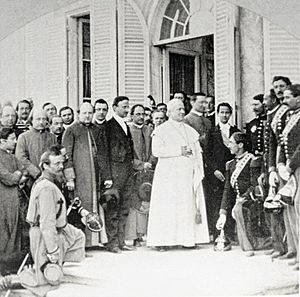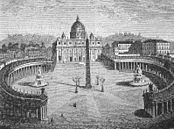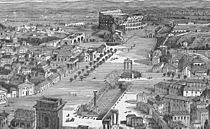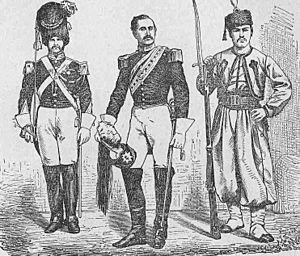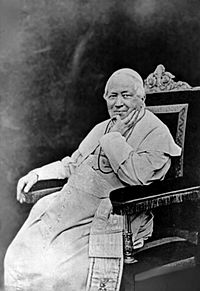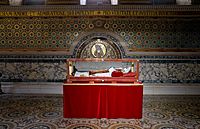Pope Pius IX facts for kids
Quick facts for kids Pope Blessed Pius IX |
|
|---|---|
| Bishop of Rome | |
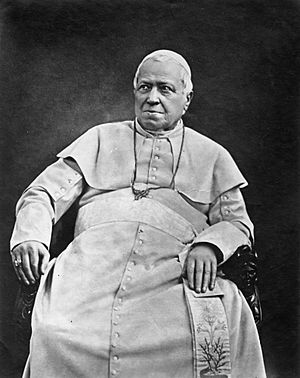
Portrait by Adolphe Braun, 1875
|
|
| Church | Catholic Church |
| Papacy began | 16 June 1846 |
| Papacy ended | 7 February 1878 |
| Predecessor | Gregory XVI |
| Successor | Leo XIII |
| Orders | |
| Ordination | 10 April 1819 |
| Consecration | 3 June 1827 by Francesco Saverio Castiglioni |
| Created Cardinal |
|
| Personal details | |
| Birth name | Giovanni Maria Mastai Ferretti |
| Born | 13 May 1792 Senigallia, Marche, Papal States |
| Died | 7 February 1878 (aged 85) Apostolic Palace, Vatican City, Kingdom of Italy |
| Previous post |
|
| Motto | Crux de Cruce |
| Signature |  |
| Coat of arms |  |
| Sainthood | |
| Feast day | 7 February |
| Venerated in | Catholic Church |
| Title as Saint | Blessed |
| Beatified | 3 September 2000 Saint Peter's Square, Vatican City by Pope John Paul II |
| Attributes |
|
| Patronage |
|
| Other Popes named Pius | |
Pope Pius IX (born Giovanni Maria Mastai Ferretti; 13 May 1792 – 7 February 1878) was the head of the Catholic Church for over 31 years. This was the longest time any pope has served after Saint Peter. He is remembered for calling the First Vatican Council in 1868. He also lost control of the Papal States to the Kingdom of Italy in 1870. After this, he stayed in Vatican City, calling himself a "prisoner of the Vatican".
When he was first chosen as pope, many saw him as a leader who would bring new, modern ideas. However, after the Revolutions of 1848, his views became much more traditional. He strongly condemned new ideas like liberalism and modernism. Pope Pius IX also made the belief of the Immaculate Conception an official teaching of the Church. This means that Mary, the mother of Jesus, was believed to be born without original sin. He was made a saint, or Blessed, by Pope John Paul II in 2000.
Contents
Early Life and Becoming a Priest
Giovanni Maria Mastai Ferretti was born on 13 May 1792 in Senigallia, Italy. He was the ninth child in a noble family. He studied at a college in Volterra and later in Rome.
In 1815, he joined the Papal Noble Guard, a special group that protected the Pope. However, he had to leave because of epilepsy attacks. He then focused on his studies to become a priest. He was ordained a priest on 10 April 1819.
He was the first future pope to ever visit America. He traveled to South America as an assistant to a Church official. Their goal was to understand the role of the Catholic Church in the new country of Chile. However, the mission did not go as planned.
After returning to Rome, he was put in charge of a hospital. In 1827, at 35 years old, he became the Archbishop of Spoleto. He became known for being kind and helping people. For example, he helped people after an earthquake. He was also seen as a liberal because he supported changes in the Papal States. He became a cardinal in 1840.
Becoming Pope: A New Beginning
| Papal styles of Pope Pius IX |
|
|---|---|
 |
|
| Reference style | His Holiness |
| Spoken style | Your Holiness |
| Religious style | Holy Father |
| Posthumous style | Blessed |
Cardinal Mastai Ferretti became pope in 1846. Many people hoped he would bring big changes to the Papal States and the Catholic Church. They even wanted him to lead Italy to become independent. He later became more traditional, which surprised many of his early supporters.
How Pope Pius IX Was Chosen
The election for the new pope happened in 1846 after Pope Gregory XVI died. The political situation in Italy was tense. Some cardinals wanted to keep things the same, while others wanted reforms.
On 16 June 1846, Mastai Ferretti was chosen as pope. He picked the name Pius IX to honor Pope Pius VII, who had encouraged him to become a priest. He was crowned on 21 June 1846.
His election made many people in Europe excited. They saw him as a leader who would bring freedom and progress. He was known for being religious, intelligent, and friendly. Even though his political ideas changed over time, his personal life was simple and humble.
Leading the Church
One of the biggest events during Pope Pius IX's time as pope was the end of the Papal States. These were lands in central Italy that the pope ruled directly. At the same time, he made the Church more centralized, meaning more power was held in Rome by the pope.
Making Decisions for the Church
Pope Pius IX used his position to speak to bishops around the world. He called the First Vatican Council (1869–1870). This important meeting helped define the idea of papal infallibility. This means that when the pope speaks officially on matters of faith and morals, he is believed to be free from error.
He also worked to protect the rights of the Church and Catholics in different countries. He fought against ideas that he felt were against Catholic teachings.
Special Celebrations
Pius IX celebrated many important anniversaries. In 1867, he celebrated 1,800 years since the deaths of Saint Peter and Saint Paul. Thousands of people came to Rome for this event. In 1871, people celebrated his 25th year as pope. He also declared 1875 a Holy Year, which was celebrated by Catholics worldwide.
Choosing New Cardinals
Pope Pius IX appointed 122 new cardinals during his time. Cardinals are important Church leaders who help the pope and elect the next one. Some famous cardinals he appointed included Vincenzo Pecci, who later became Pope Leo XIII, and John McCloskey, the first American cardinal.
Recognizing Saints
Pope Pius IX made 52 people saints. He also declared 222 people "Blessed," which is the step before becoming a saint. He named three new Doctors of the Church. These are saints recognized for their important writings and teachings.
Ruling the Papal States
Until 1870, Pope Pius IX was not just the head of the Church. He was also the ruler of the Papal States. These were lands in central Italy where he governed like a king.
Changes in the Papal States
At first, Pius IX made many liberal changes. He freed political prisoners, which made him very popular. He also improved farming and trade. He built new roads, bridges, and railway lines. He even brought gas lighting and the telegraph to the Papal States.
However, the justice system in the Papal States faced criticism. There were also criminal gangs that made travel and trade unsafe.
The Pope's Army
In 1859, the papal army had about 15,000 soldiers. There was also a special group called the Swiss Guard. They served as the Pope's personal bodyguards.
Education and Arts
Pius IX supported universities in Rome and Bologna. He also loved the arts. He helped restore churches in Rome and the Papal States. He ordered repairs to the Colosseum and supported the study of ancient Christian burial sites called catacombs.
Jewish Community in Rome
The Papal States were a theocracy. This meant the Catholic Church had more rights than other religions. At the start of his time as pope, Pius IX opened the Roman Ghetto. This allowed Jewish people to live outside this special area. However, after he returned from exile in 1850, he brought back some strict rules, including the ghetto.
A famous case happened in 1858 involving a 6-year-old Jewish boy named Edgardo Mortara. Police took him from his parents. A Christian servant had secretly baptized him when he was a baby. Papal law said that Christians could not be raised by Jewish families. This event caused a lot of anger across Europe. The boy was raised in the Pope's home and later became a priest.
Relations with Other Countries
Pope Pius IX was the last pope to rule a country. In 1870, the new Kingdom of Italy took over the remaining Papal States. The Pope refused to recognize this new kingdom. He saw it as an illegal takeover. He even excommunicated the leaders of Italy.
Italy and the End of the Papal States
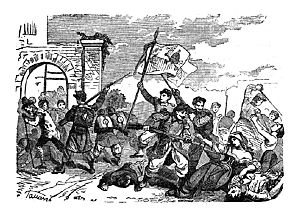
When Pius IX first became pope, he freed political prisoners. But these revolutionaries continued their activities. They wanted Italy to be united under the Pope's leadership. However, Pius IX refused to go to war with Austria. This made him less popular in Italy.
In 1848, his Prime Minister was killed. The Pope then escaped Rome. A Roman Republic was declared. Pius IX excommunicated everyone involved. After the republic was put down, he returned to Rome in 1850. He decided to live in the Vatican, where popes have lived ever since.
In 1860, the Kingdom of Sardinia took over most of the Papal territories. In 1870, Italian troops invaded Rome itself. The Pope told his soldiers to offer only a small resistance. He did not want bloodshed. When the city walls were broken, he ordered a white flag to be shown. This was his last act as ruler of the Papal States.
England and Wales
For a long time, England was seen as a mission area for the Catholic Church. In 1850, Pius IX brought back the Catholic Church's official structure in England and Wales. This led to some protests against what people called "papal aggression."
United States
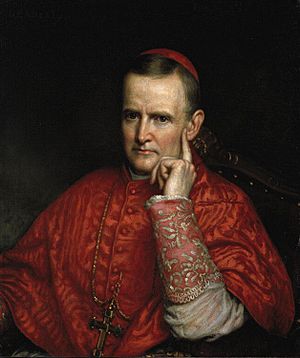
In 1847, Pope Pius IX approved the request of American bishops. They wanted the Immaculate Conception to be the special protector of the United States.
During the American Civil War, the Pope sent letters to American bishops. He called for an end to the "destructive Civil War." The Vatican never officially recognized the Confederate States of America. However, the Pope did meet with a Confederate representative. He emphasized the need to end slavery. In 1875, Pius IX made Archbishop John McCloskey of New York the first American cardinal.
Canada
Pope Pius IX greatly increased the number of Catholic areas (dioceses) in Canada. He helped the Church grow there.
Germany
In Germany, the state of Prussia tried to reduce the power of the Catholic Church. This was known as the Kulturkampf. Catholics fought back by voting. After Pius IX died, the German leader Otto von Bismarck made peace with the new pope.
Russia
Pius IX tried to improve relations with Russia. He allowed the pope to appoint bishops in Russia and Poland. However, these freedoms did not last long. After a Polish uprising in 1863, Pius IX sided with the Poles. He protested against their persecution. This angered the Russian government, and Catholic dioceses were removed.
Later Years and Passing Away
From 1868, the Pope suffered from health problems. Despite this, he continued to celebrate Mass every day. He had several painful medical procedures, which he handled with great patience.
Pope Pius IX lived long enough to see his old rival, Victor Emmanuel II of Italy, die in January 1878. He forgave the king of all Church punishments. Pius IX passed away one month later, on 7 February 1878, at the age of 85. He was praying the rosary with his staff. His last words were, "Guard the Church I loved so well and sacredly." His death marked the second-longest time any pope had served.
His body was first buried in Saint Peter's grotto. Later, it was moved to the Basilica of Saint Lawrence outside the Walls. During the move, some anti-Church people tried to throw his coffin into the river. But soldiers arrived and stopped them.
Becoming Blessed
The process to make him a saint began in 1907. It was strongly opposed by the Italian government for many years. However, Pope John Paul II declared him "Venerable" in 1985. Then, he was declared "Blessed" on 3 September 2000. This means he is recognized as having lived a holy life.
Some people criticized his beatification. They pointed to his strict political views and the case of Edgardo Mortara.
Pope Pius IX's Legacy
Pope Pius IX's time as pope was the longest in history after Saint Peter. Even though he lost his power as a ruler, the Church became more united around him. His time as pope marks the start of the modern papacy. From his time on, the pope became more of a spiritual leader than a political one.
He started as a liberal but became more traditional after being forced to leave Rome. He was a strong reformer of Church life and structures. Church life, religious vocations, and new religious groups all grew during his time.
He made important Church history with his official declaration of the Immaculate Conception in 1854. His other lasting contribution was calling the First Vatican Council. This council officially defined the idea of papal infallibility. He also helped John Bosco start the Salesian Society. Because of this, he is sometimes called "Don Bosco's Pope."
- After he freed political prisoners in 1846, thousands of Romans celebrated him. They pulled his carriage through the streets themselves.
- In 1848, revolutionaries demanded war against Austria. The Pope refused, saying his role as head of state and Church did not allow it. His palace was then attacked.
- When Italian troops approached Rome in 1870, the Pope told his small army to offer only a symbolic resistance. He did not want bloodshed.
- He was the first pope to be photographed.
- He loved trains! After riding one in 1849, he promoted building railways in the Papal States. He also introduced gas lighting and the telegraph.
- A street in Montreal, Canada, is named Pie-IX Boulevard after him. There are also streets and a school named Pío Nono in other parts of the world.
- A type of sweet in Spain, Latin America, and the Philippines is called piononos.
Images for kids
-
The First Vatican Council presided over by Pius IX, 1869
-
Pope Pius IX (here pictured c. 1864) proclaimed two dogmas
-
Illustration of the funeral of Pius IX at Saint Peter's Basilica, published by Currier and Ives in 1878
-
Portrait by George Peter Alexander Healy, 1871
See also
 In Spanish: Pío IX para niños
In Spanish: Pío IX para niños
- List of encyclicals of Pope Pius IX
- List of popes by length of reign


